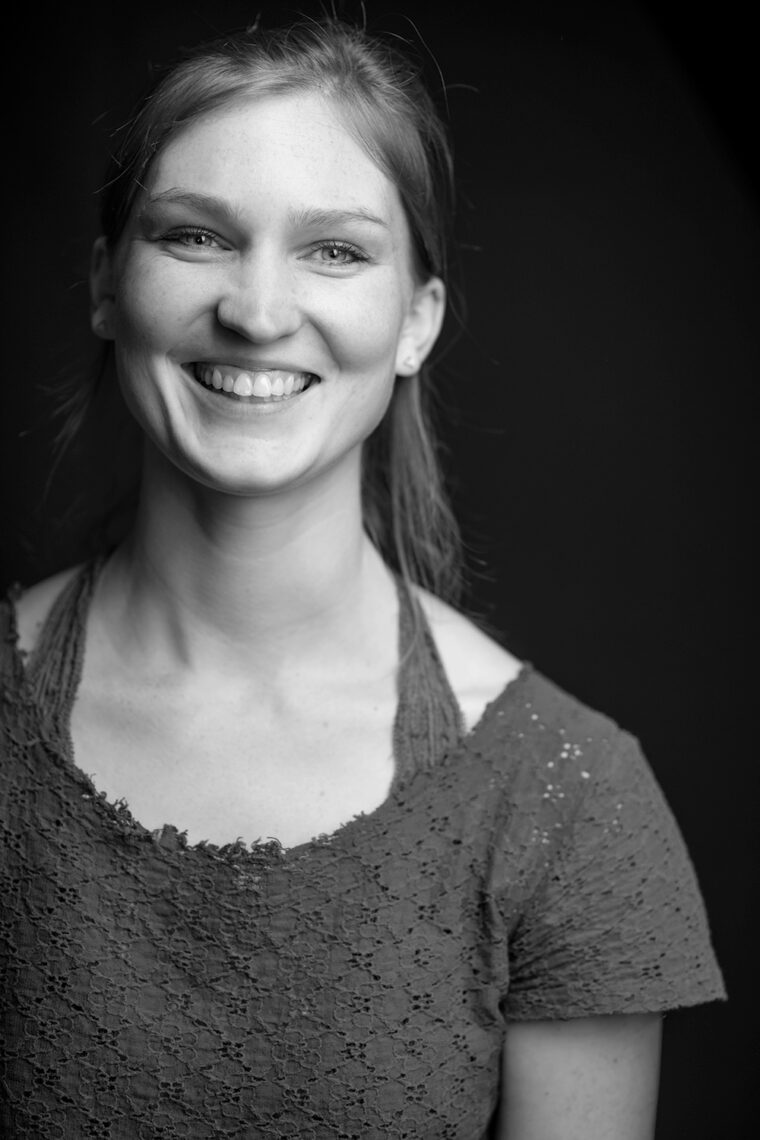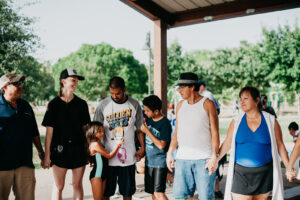Forklift’s LaMotte ’18 Discusses Upcoming WesWorks Performance
On Oct. 14, Forklift Danceworks will present WesWorks, a performance that celebrates the skilled movement and tells the often unheard stories of the people whose work sustains the daily lives of the Wesleyan campus.

In this Q&A we speak with Gretchen LaMotte ’18, choreographer and programs manager for Forklift Danceworks. At Wesleyan, LaMotte majored in science in society while working for the Center for the Arts’ Creative Campus Initiative, Zilkha Gallery, and the Institute for Curatorial Practice in Performance.
Q: Hi Gretchen! In October, Forklift will host the performance of “WesWorks,” featuring members of Wesleyan’s Physical Plant staff and campus custodians. Can you describe the process and the goal?
GL: “WesWorks” is about honoring, celebrating, and supporting the people whose work sustains campus life. The core of the process is relationship-building, which we do by spending time with partnering employees on the job, working alongside them as much as possible, and interviewing them about their work. Because we’re visitors to campus, we’re working to support students to be part of that process, and we’re lucky to be building on seven years of work between Physical Plant, students, and Forklift.
The goal is for the performance to be a catalyst for a bigger cultural shift, where understanding the work it takes to maintain campus and getting to know the people who do that work is central to everyone’s Wesleyan experience. What exactly that looks like is up to the campus community to shape — we’ve brought together an Advisory Committee with faculty, students, administration, and facilities employees to begin to envision that and think about what comes next. It’s a great way to get involved if you’re excited about this project!
Q: Do bonds/friendships tend to form between the students and staff throughout the process? Do students make a greater connection, or have a deeper understanding, of Wesleyan’s “behind the scenes” personnel?
GL: Yes! And this is one of the most important things about the work. We have students who worked with Physical Plant staff their freshman year and now, as seniors, still talk regularly or even work together. We consistently hear students report that working with campus staff is one of the best experiences they’ve had at Wesleyan, that it has reshaped their understanding of campus sustainability efforts, taught them concrete skills, and transformed their experience of community. Partnering staff also have shared appreciation for making that personal connection with students and teaching them about their trade. Once they’ve worked together, students and staff say hi when they see each other around campus, and communicate more effectively about repairs or things that come up in campus buildings. Those things might sound small but they contribute to building a more inclusive, connected community that shares responsibility for campus spaces.

Q: You mentioned Wesleyan’s seven-year partnership with Forklift. Can you share examples of past collaborations?
GL: Allison Orr first came to campus in 2014 as a Creative Campus Fellow, and returned in 2015-16 as the Menakka and Essel Bailey ‘66 Distinguished Visiting Scholar in the College of the Environment. Clara Pinsky ‘16 led a student forum in 2014 that collaborated with Physical Plant, and later created a performance with Physical Plant employees as her senior dance thesis. She also started a home maintenance course for credit taught by Physical Plant staff. Forklift has led several student workshops and since 2018, we’ve partnered with faculty from the and Dance Department to offer job shadowing and creative projects as part of existing classes. In many ways, this has given us a sort of laboratory to explore how to teach these methods, as Allison has been finishing a book about her process to be published by Wesleyan University Press. It has been a real gift to have such a longstanding partnership with Wesleyan, and has helped make it possible to continue this project through the pandemic.
Q: When did you become involved with Forklift?
GL: My sophomore year, I heard Allison speak and was immediately drawn to Forklift’s work. I had a background in dance—I took a few years off after high school to pursue dance before college—but at the time I had been feeling ambivalent about how dance might be part of the work I wanted to do.
I decided to take Allison’s class that spring. I was excited about the class because it combined theory and practice, so we learned about Forklift’s process and some broader context and history of community-based art practice, and we got to actually practice it ourselves. We made a dance with employees of the Middletown Water and Sewer Department … it shaped how I was thinking about dance, performance, and civic engagement throughout my time as a student. In 2017, I received a COE fellowship to intern with Forklift in Austin, Texas for the summer. I continued working with them remotely through my senior year and was fortunate that they were able to offer me a job when I graduated.
Q: Can you elaborate on your experience with the Water and Sewer project?
GL: My classmates and I showed up at the wastewater treatment plant once or twice a week at 7 a.m. to work with Al, Pat, Robbie, and Vinny as they checked the water flow, tested the water, and pumped sludge. I eventually made a dance with Al Sanders, the head of the plant, and we are still in touch today. The same semester, I took a home maintenance course with Physical Plant organized by Clara Pinsky ‘16 connected to her senior thesis project with them. I learned concrete skills as we helped with a renovation at the Cady Building, where Physical Plant is based, and also got to know some of the employees as we worked together. That shifted my experience on campus for the next three years, because I would get to catch up with them when I saw them around and made me more conscious if I had to request a repair or had a maintenance issue — it was all warmer and more personal. It’s always important to me to acknowledge how much I get out of the work I get to do, and it certainly made my experience at Wesleyan richer. And I’ve been lucky to keep facilitating job shadowing and collaboration for students and staff in my work with Forklift ever since!
For me, the process integrated my love of storytelling and self-expression through dance performance with a love for being with people and listening.
Q: What is unique or stands out about community-based performance and collaborative dance-making as opposed to traditional performances?
GL: There’s something really powerful about people sharing their own stories and expertise through performance. I love supporting people to be who they are in our shows; I see so much potential in that. The work is to make sure the project supports the partnering community’s needs and shares leadership in creating the performance narrative and content.
Q: Is it difficult teaching someone with no performance experience how to move, act, and dance? How do you break someone from his or her comfort zone? Does Forklift, or the students, meet much resistance with the participants?
GL: We’re really not teaching people. As a choreographer, I’m working with the experts — these employees have developed skilled movement through years of work and training. If you’d seen me trying to operate a backpack vacuum as smoothly as Teresa, a custodian I worked with at Wake Forest University, you’d know I’m the novice here! At Forklift, we see those skilled movements of work as dance. We often describe ourselves as facilitators, noticing the expertise of partnering employees and working with them to translate that into performance. I often ask people, “How could we tell the story of that part of your job?” and then we work together to create a choreographic scenario out of the movements they’re already doing. Often, we are asking people to do something new by getting in front of an audience — so we work to build community and have a strong team of stage managers whose job is really just to be with the performers throughout the show and make sure they have the support they need. There is often some skepticism at the beginning of the project, but we often find that as people get to know us and excitement builds for the performance, more and more people want to be involved. Participation is always voluntary, and we make sure performers are paid for their time.
Q: During job shadowing, what are students advised to look for and observe? How are they taught to translate these observations into a choreographed movement?
GL: We encourage students to come with curiosity, humility, and a readiness to work. It’s important to do the work alongside partnering staff as much as possible — learning and following all the safety parameters and rules of the job. This is not only a great way to build trust and get to know each other, it also gives students an embodied experience of the work they’re learning about. We also talk a lot about listening — for what’s important to people, what they want the public or the campus to know, and what they are excited about sharing. We ask students to notice what’s already there: the technical expertise of the work, movements and jobs that their partner excels at, what they’re excited about creatively as well as what their partnering employee is excited about. We always ask employees, “what do you want people to know?” and that question gives students direction. The choreography often begins to emerge through the job shadowing process and is really devised with the partnering employee, often through questions and collaborative exchange (“How could you do that job in 2 minutes instead of 10?”). Especially when students are doing this process in just one semester (which is super short!), the choreography can happen quickly because it emerges from the skilled movements employees are already performing every day.
Q: What do you find to be the biggest takeaway from your performances?
GL: The felt experience of connectedness, mutual respect, and shared accomplishment is something I have not quite found anywhere else. So much goes into making these performances happen and everybody involved has an important part to play, and that creates real bonds across the group. We get to see each other’s humanity, honor people’s stories, and, at least for a time, share in a world where people are witnessed and recognized for who they are.

